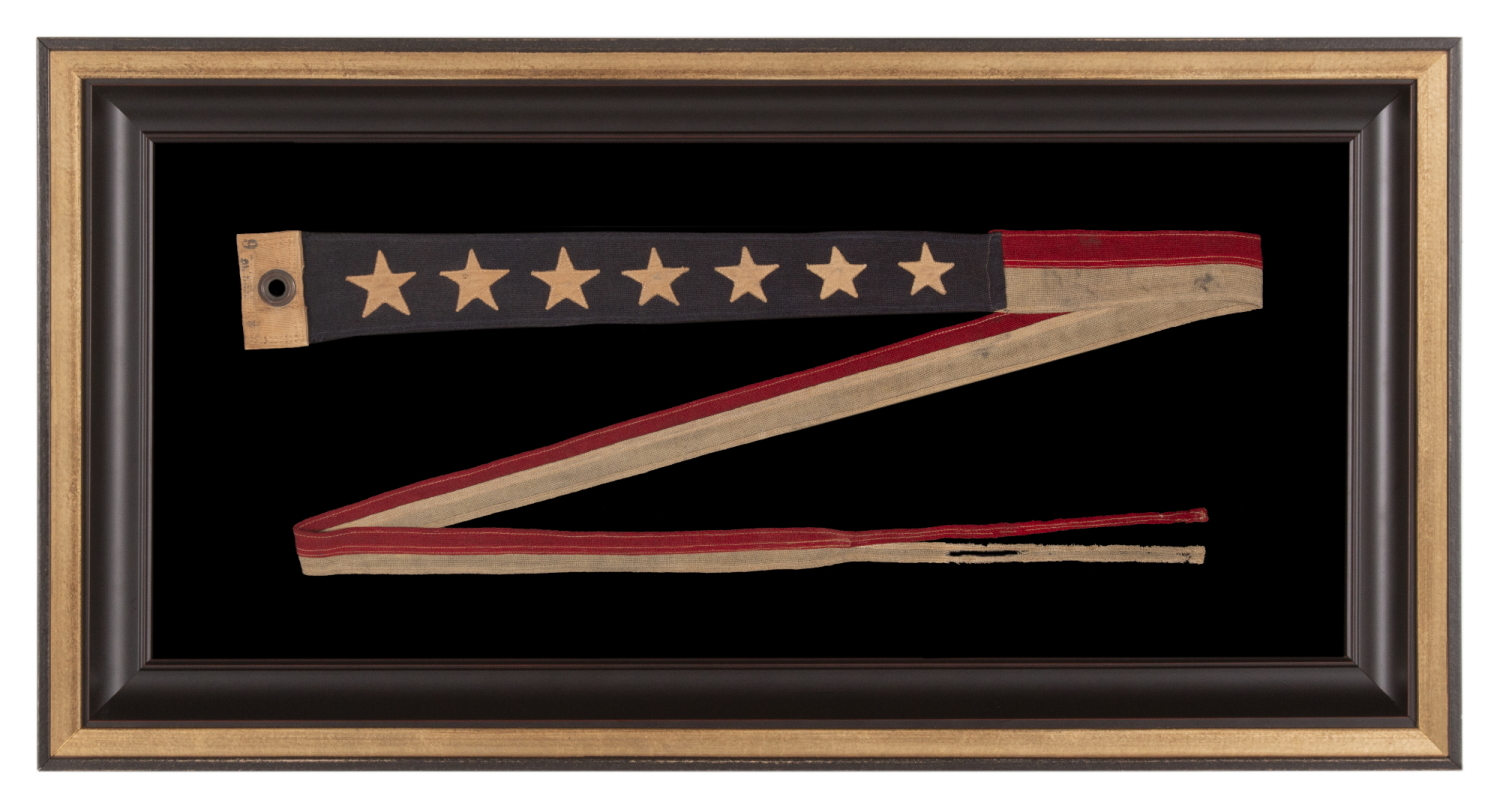
| |
“NO. 6” U.S. NAVY COMMISSION PENNANT WITH 7 STARS, MADE SOMETIME DURING THE WWI - WWII ERA (1917-1945), WITH ENDEARING WEAR |
|
| Available: |
Sold |
| Frame Size (H x L): |
17.25" x 33.5" |
| Flag Size (H x L): |
2.75" x 66.25" (unfurled) |
|
| Description....: |
|
7 star, U.S. Navy, ship's commission pennant, made sometime between roughly WWI (U.S. involvement 1917-18) and WWII (U.S. involvement 1941-45). Commission pennants are the distinguishing mark of a U.S. Navy ship. A ship becomes commissioned when this pennant is hoisted. Flown during both times of peace and war, the only time the pennant is not flown is if a flag officer or civilian official is aboard and replaces it with their own flag.
Commissioning pennants were once very important in their role as signals, needing to be seen from great distance. During the 18th and 19th centuries, they usually exceeded ten feet in length, with some reaching as long as a hundred feet. Also termed “Narrow Pennants” by the Navy, in 19th century regulations, these technically fell between 6 feet on the fly, and 70 feet. Sometime around 1910, the function of commission pennants leaned away from identification and more toward ceremony and custom. Although they appear in 1912 regulations in seven sizes, still ranging up to 70 feet, by WWI most were one of just two sizes and tiny compared to their predecessors, measuring just 4 or 6 feet on the fly.
Early on, commission pennants had a number of stars equal to that on the national flag. As more and more states joined the Union, however, it became impractical to use the full complement of stars, especially on smaller examples. During the mid-late 19th century, many substituted 13 stars for the full count, to reflect the original colonies. This mirrored the star count used by the Navy on most of the Stars & Stripes flags that it flew on small craft. "U.S. Navy small boat ensigns," as they are called, most often had 13 stars.
In the latter half of the 19th century, the smallest examples sometimes displayed just 7 stars. It is of interest to note that, according to the U.S. Navy, the reason for the choice of 7 stars was not recorded. I once suspected this the number might logically reference the "7 Seas", before I discovered that this is a mythicized, ancient term, and geographers disagree on the precise meaning. The number may just as likely have represented what seemed like a logical design choice, when the overall length was substantially shortened.
Star counts for “Narrow Pennants” remained unspecified during the 19th century. They first appear in 1912, with the 7 star count specified for 4, 6, and 9-footers, and the 13 star count specified for all larger examples.
For some reason, many 20th century examples display two different sizes of stars, usually with 4 larger, followed by 3 smaller. This may also have been a matter of practicality, because the severity of the taper was so much greater on a 4-6 foot pennant, versus, say, a 20 or 40-foot example.
The body of this particular pennant is made of wool bunting. The cotton stars are appliquéd with a zigzag, machine stitch. There is a sailcloth canvas binding along the hoist, with a single, white metal grommet, along which the word “commissioning” was stamped in blue, followed by the numeral “6,” which specified the numeric designation in 1912 U.S. Navy regulations, as well as the overall length in feet.
Mounting: The pennant was folded back-and-forth in an interesting zigzag fashion. It was mounted and framed within our own conservation department, which is led by expert staff. We take great care in the mounting and presentation of flags and have preserved thousands of examples.
The background fabric is 100% cotton twill, black in color. The cove shaped molding has a very dark brown finish, almost black, with red undertones and highlights. To this a black-painted, hand-gilded and distressed Italian molding was added as a cap. Spacers keep the textile away from the glazing, which is U.V. protective glass. Feel free to contact us for more details.
Condition: Although the specific history has been lost to time, the pennant was definitely flown for an extended period and shows every indication thereof. There are traces of what appears to be great paint in the red and white striped field, near the blue union. There is some fading of the blue wool bunting and a general, overall, moderate oxidation of the white stars and binding, along with some soiling. There is some fabric breakdown, with associated loss and fraying, at the forked, fly end. Many of my clients prefer early flags to show their age and history of use. |
|
|
|
| Collector Level: |
Beginners and Holiday Gift Giving |
|
| Flag Type: |
Sewn flag |
|
| Star Count: |
07 |
|
| Earliest Date of Origin: |
1917 |
|
| Latest Date of Origin: |
1945 |
|
| State/Affiliation: |
|
|
| War Association: |
WW 2 |
|
| Price: |
SOLD |
|
| |
Views: 1079 |
|
|
|

